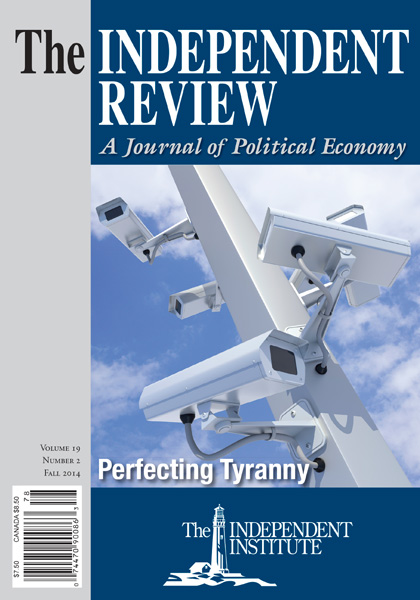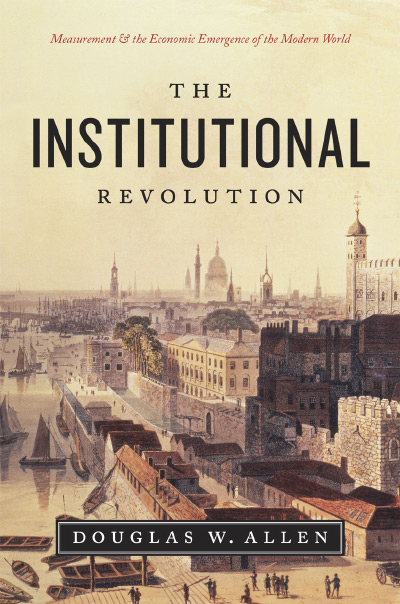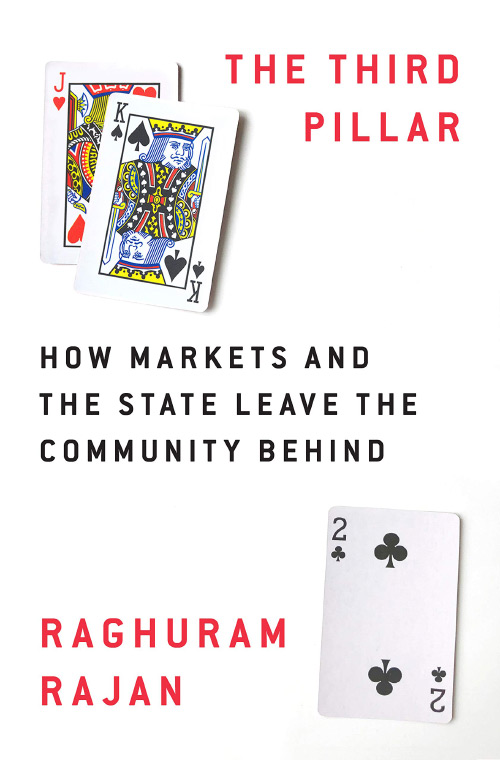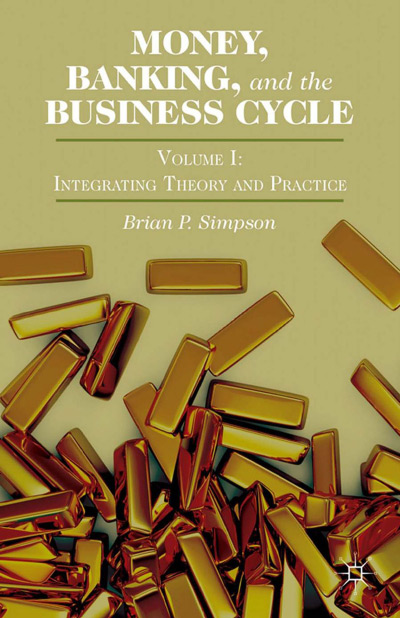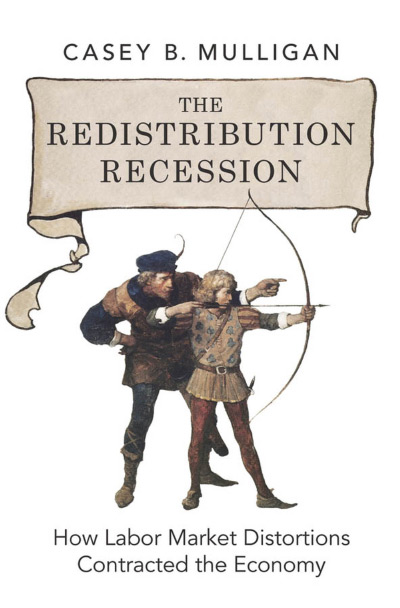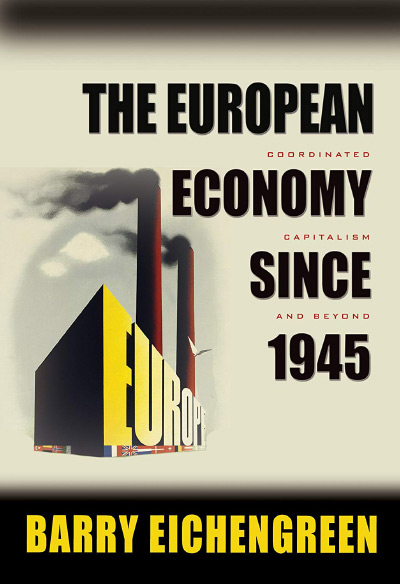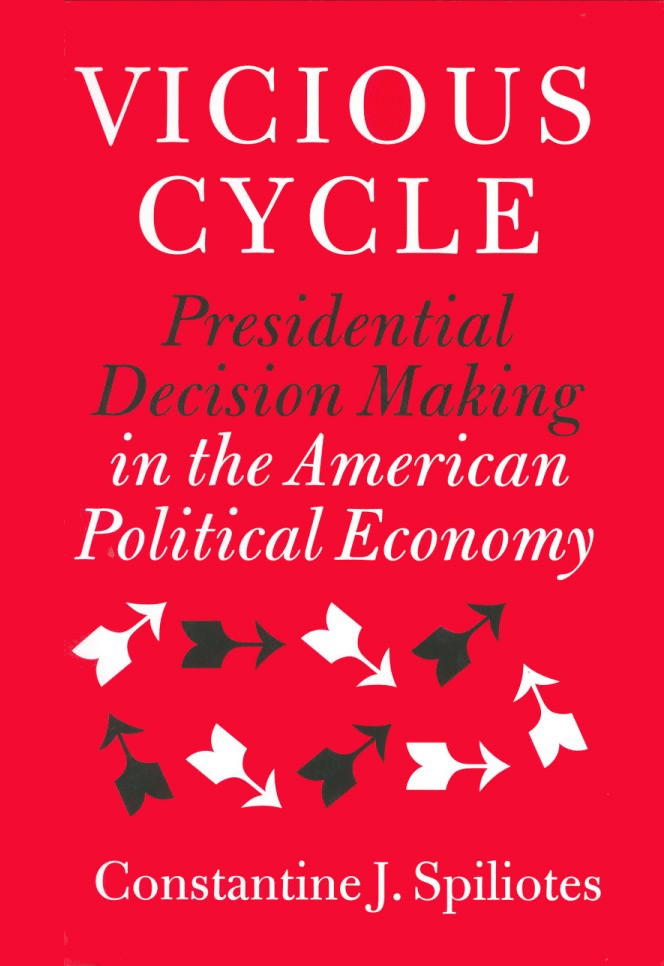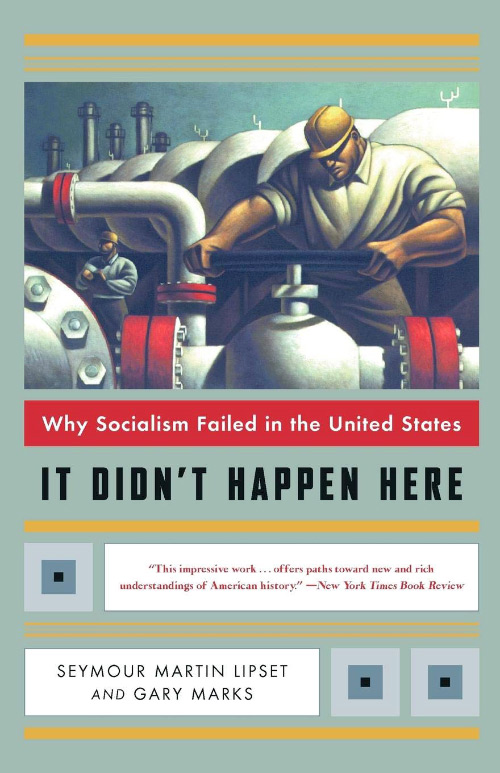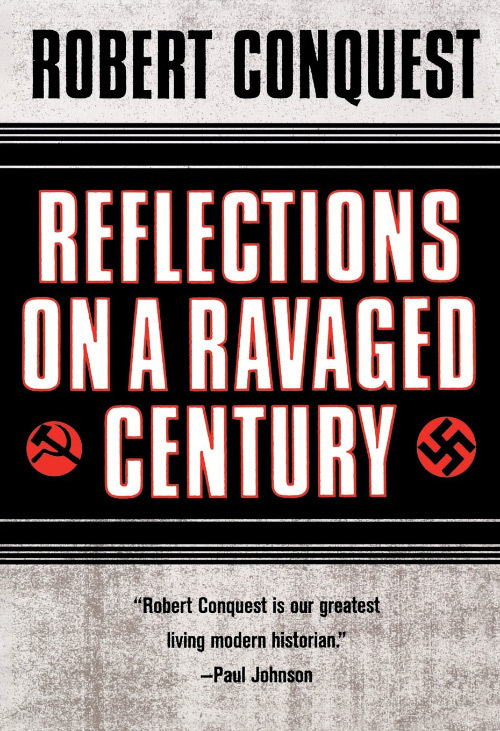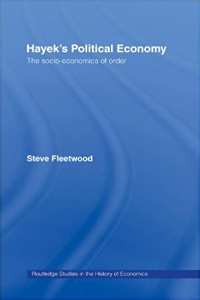“Institutions matter” is a—or perhaps “the”—mantra of the public-choice and Austrian economics research programs. But institutions also play central roles in scholarly work lying mostly beyond the boundaries of those two traditions, including that of, among others, economic historians (e.g., Douglass North and Joel Mokyr); students of the organization of the firm and of the industries populated by business enterprises (Ronald Coase and Oliver Williamson); and contributors to the modern literatures on the evolution of property rights (Harold Demsetz, who is missing in action here, and Yoram Barzel), the common law, and commercial law (Coase again and Bruce Benson, also MIA).
Douglas Allen, relying heavily on Coasian transaction costs and models of principal–agent relationships, theoretical ideas to which he has devoted his own attention throughout much of his academic career, writes that he eventually realized that an institutional revolution, running “between roughly 1780 and 1850” (p. xii), propelled the more familiar Industrial Revolution, which began around 1750, according to most students of economic history. In The Institutional Revolution, Allen summarizes the evidence he sees as supporting the conclusion that new technologies, such as reliable timepieces, and new institutions, such as “professional” public-sector bureaucracies and standard weights and measures, were necessary, if perhaps not sufficient, for driving the economic progress that has enriched the nations of planet Earth.
Allen begins in chapter 1 by describing what he calls “the pre-modern world,” wherein individuals lacked “the ability to measure basic fundamentals such as time or distance” (p. 8). He quotes liberally from Samuel Pepys’s famous Diary (kept during the second half of the seventeenth century) to show the reader that many important meetings never happened owing to the absence of reliable (and synchronized) clocks as well as to the unavailability of dependable, steam-driven transportation modes and power sources (as discussed in chapter 2, such deficiencies magnified the variances of outputs relative to inputs). Was the person whom Pepys (or anyone else) had been scheduled to meet simply dilatory, or could a missed appointment instead be explained by mutual mistakes in estimating the meeting’s actually scheduled time? Was a shipment of cargo delayed because of the vagaries of wind, weather, and tides in the age of sail or because of some failure on the part of the captain or crew? No clear answers could be given to such questions, and, in consequence, “shirking” (evasion) of responsibilities was widespread.
As Allen remarks, the trustworthiness of one’s agents was, then as now, of first-order importance. The institution of political patronage reduced the cost of ensuring satisfactory performance by “the Crown’s” senior and junior administrators. Kinship or other personal ties and word-of-mouth endorsements from members of the aristocracy facilitated but of course did not guarantee the selection of reliable agents at a time when on-the-job monitoring frequently was impractical. Moreover, because most offices obtained through patronage could not be resold (p. 16), the threat of the loss of one’s post (and the future income associated with it) was the only constraint on bureaucratic ineptitude or malfeasance—for example, “fiddling” the office’s books for personal rather than the monarch’s gain. Thus, one drawback was that “an office granted by patronage was more likely to be held by an incompetent person than one granted by purchase or merit” (p. 17). And so patronage’s informational benefits gradually were reinforced by requiring individuals to purchase the civil offices to which they had been appointed. Buying a governmental post supplied the incumbent with strong incentives to maximize the value of the position to himself and to his patron, who stood toshare in that value (p. 15). With some exceptions (described later), patronage and the sale of public offices extended throughout the British government and seem to have worked tolerably well as long as “the civil administration was relatively small” (p. 17).
However, as the (British) civil service grew in both the size and the scope of policy responsibility, the “system of trust” facilitated by patronage and venal public offices tended to break down because bureaucratic expansion “required additional institutions for monitoring the trustworthiness of officeholders”; “the incentive to use professionals arose from the [transaction] costs of sale and patronage.” In particular, “salaried workers require[d] monitoring” (p. 17). Yes, but as far as the civil service is concerned, Allen seems to be completely unaware of the literature inquiring into the incentives of bureaucrats (e.g., the work by Gordon Tullock, William Niskanen, and James Q. Wilson) written since the Progressive Era. He never questions his (or the Progressives’) implicit assumption that a “professional,” “salaried” civil service is more “efficient” and less influenced by politics than one filled by individuals who either purchased their public offices or were appointed to them by patrons. Allen ignores completely the behind-the-scenes institutional details of “the Crown.”
Generally speaking, only aristocrats were appointed to important public offices, and the willingness and ability to pay for those offices were not the only ways that individuals could prove their trustworthiness and commit credibly to serving the interests of the central British government. In chapter 3, Allen discusses the myriad strategies by which entre´e into the aristocracy was achieved and eligibility for public service was demonstrated. His analysis focuses on what we today call “hostage capital,” defined in the case at hand as nonsalvageable investments in “fidelity and good conduct” (p. 56). Ownership of “land was always the defining attribute of the aristocracy—the test of rank and position” (p. 53) during the premodern period and beyond. But, in addition, a budding aristocrat usually had to hold most of that land on an “isolated estate” (p. 63), which possessed mainly ornamental as opposed to agricultural value; marry well and adhere to the so-called strict family settlement, which institutionalized primogeniture to keep the estates intact (pp. 65–68); be educated at the “right schools” in fields of study (such as Latin, Greek, music, dance, taste, and good manners) having “few alternative uses” beyond signaling (p. 69); and, perhaps what is most important, abandon any personal interest in “merchant enterprises” (p. 54)—the bourgeoisie need not apply. Once again, according to Allen, the values of such investments were undermined when “measurement [of performance] could substitute for trust” (p. 78).
Chapter 4 contains Allen’s analysis of duels as an institution “designed to keep pretenders out” (p. 83). Duels of honor were restricted to members of the aristocracy in good standing, were often provoked by “trivial” affronts, and were rarely lethal (“most deaths . . . resulted from infections rather than the wound inflicted” [p. 96]). Although dueling was illegal, it rarely was prosecuted, and if one of the parties was convicted, he almost always was pardoned (p. 85). “Although [Aaron] Burr killed [Alexander] Hamilton” and “was never convicted or even tried for murder” (p. 100), it is too bad in my view that the duel did not happen earlier because Hamilton, as President Washington’s first treasury secretary, was the promoter of a strong central government and the architect of America’s return to the hated excise tax, which triggered the Whiskey Rebellion in western Pennsylvania soon after the ink was dry on the Constitution written at Philadelphia in 1787.
Allen compares and contrasts the Royal Navy and the Crown’s “boots on the ground” in chapters 5 and 6. Because “the captain had a large advantage over the Admiralty in London in terms of knowledge of local conditions” around the far-flung corners of the world (see, in particular, Patrick O’Brian’s novels describing Jack Aubrey’s naval service during the Napoleonic era of wooden ships and iron men—a must read for anyone who values good writing), captains were assigned to ships mainly “through patronage” (p. 111). But, in addition, the British navy’s captains, officers, and crewmembers also could earn incomes on the basis of predetermined shares of the values of enemy ships captured: “Shares in prizes were based on rank” (p. 110), but even the lowest able-bodied seaman received a share, supplying him with incentive to exert effort toward the collective goal; “‘head money’ was paid based on the number of sailors on the opposing vessel” as well as for “capturing a slave ship” (p. 111). Although promotion to the upper officer ranks was based on patronage, everyone’s incentives were more closely aligned with those of the Crown because, especially for ships’ officers, there existed an elastic supply of replacements (p. 122), and for ordinary seamen the opportunity cost of naval service was either a job in the merchant marine or the illegal occupation of piracy (see Peter Leeson’s book The Invisible Hook: The Hidden Economics of Pirates [Princeton, N.J.: Princeton University Press, 2009]).
Monitoring of naval performance from London was reduced further by requiring junior officers—called “watch dogs” (p. 124)—to keep logbooks documenting more senior officers’ compliance with the navy’s “Fighting Instructions” and other rules of conduct. All such logbooks had to be signed by their writers and submitted to the Admiralty (not to the captain) at voyage’s end. As far as the British army was concerned, purchase of rank was the main path to an officer’s commission and for promotion up the ranks. Such ranks were treated as property that could be resold, and, indeed, because ranks could not be skipped (p. 154), “no one could move up in rank without selling his current position, and one sale led to another” (p. 155). “All purchases were subject to the approval of the Crown” (p. 155). But once one was “promoted past the rank of lieutenant colonel, the commission could not be sold” (p. 155). As was the case for naval officers, the low salaries paid to British army officers were supplemented by assigning rank-based shares in the values of military stores and other prizes captured from the enemy; “looting was not considered a form of prize money” (p. 155). Those rights, along with the relatively low cost of monitoring the army’s performance in France or on the Iberian Peninsula from across the English Channel, helped create incentives to exert proper fighting effort on the battlefield. Two exceptions help Allen prove that rule: because artillerymen could be monitored more easily than ground troops, “the ordinance corps was paid by salaries, not by prizes” (p. 163), and “the Royal Marines,” essentially seafaring soldiers, “did not purchase their commissions” (p. 164).
Allen shifts his attention in chapter 7 to “three additional venal offices: lighthouses, roads, tax farms” (p. 173). The first two of those goods and services, now widely assumed to be proper functions of government owing to nonrivalry in consumption and the inability to exclude users who have not contributed to financing them, were at one time supplied by the private sector, although typically carried out in the shadow of grants of exclusive provision rights by the Crown. “Tax farms,” an institution whereby private business entities paid lump sums up front for the right to collect duties, excise taxes, and other fees owed to the Crown— under contracts that allowed them to keep the differences between revenue collected for the public treasury and expenses incurred—likewise, according to Allen, were relatively efficient means of outsourcing public finances during times when a professional “Inland Revenue” department was still a only gleam in the king’s or queen’s eye. Puzzlingly, Allen does not mention any of the many abuses of the tax farmers, who obviously had strong bottom-line incentives to ferret out hidden taxable items in private homes and places of business. It is not for nothing that selective excise taxes and their collectors were hated above all other Crown functionaries. But collusion between merchants subject to taxes and tax-collecting agents who “accepted bribes to reduce the amount of tax [owed]” apparently was common (p. 186).
Allen’s last substantive chapter (chapter 8) recounts the evolution of law enforcement from Britain’s premodern period to its postmodern one. He again suggests that innovations in measurement (facilitating, inter alia, the replacement of crafts production by mass-production methods) propelled the shift from private to public law enforcement. In doing so, he once again ignores the theories and evidence advanced by Bruce Benson and other contributors to the public-choice and Austrian literatures documenting the parochial benefits to the Crown of substituting penalties for violating the king’s peace (fines escheating to the public treasury and incarceration) for restitution paid by a lawbreaker to his victim for violating the (private) peace. The incentives of public police forces and of district attorneys differ markedly from those who are harmed by criminal activities.
The Institutional Revolution is a fun read, containing many interesting historical anecdotes. But Allen has failed to advance an overarching theory of institutional change. Had he read the public-choice, Austrian, and law and economics literatures more deeply, he could have written a book with far wider implications than the volume at hand. I cannot recommend it to my colleagues in those fields, who will find themselves as disappointed as I have been by the author’s comparative neglect of the institutions of government.
| Other Independent Review articles by William F. Shughart II | ||
| Spring 2023 | FDR’s Gambit: The Court Packing Fight and the Rise of Legal Liberalism | |
| Winter 2022/23 | The Chevron Doctrine: Its Rise and Fall, and the Future of the Administrative State | |
| Spring 2020 | The Naked Emperor: Politics without Romance in The Calculus of Consent | |
| [View All (9)] | ||

